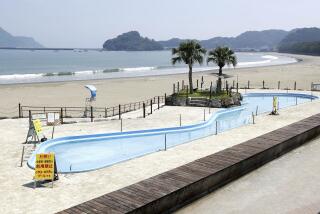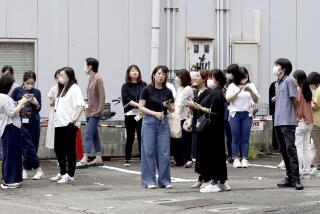Radioactive leak follows Japan quake
- Share via
TOKYO — Nine elderly people were crushed to death in an earthquake Monday off Japan’s west coast, a powerful undersea shudder that left more than 1,000 injured and caused a small amount of radioactive water to leak into the Sea of Japan.
The leak at the world’s largest nuclear power plant, which was discovered and reported only several hours later, brought a flurry of criticism even though the facility’s owner said it posed no health threat.
For the record:
12:00 a.m. July 18, 2007 For The Record
Los Angeles Times Wednesday July 18, 2007 Home Edition Main News Part A Page 2 National Desk 0 inches; 27 words Type of Material: Correction
Japan quake: An article in Tuesday’s Section A said elections for the upper house of Japan’s parliament were scheduled for Aug. 29. The date is July 29.
Prime Minister Shinzo Abe, embroiled in closely contested elections for Japan’s upper house on Aug. 29, said the company had taken too long to account for the leak and ordered it to review safety procedures.
Fears of an additional leak were raised today when the company acknowledged that drums of low-level waste had been toppled -- although the plant did not confirm Japanese media reports that tops came off some of the barrels.
Japan’s nuclear industry, which operates 55 plants atop some of the Earth’s most volatile tectonic plates, has a history of covering up accidents.
Rescue workers were still sawing through piles of debris today, searching for survivors.
The magnitude of the quake was estimated by Japan at 6.8 when it hit at 10:13 a.m. on a national holiday. The U.S. Geological Survey estimated its magnitude at 6.6.
It struck in a largely rural region of Niigata and Nagano prefectures, where many older houses are made of wood. The traditional buildings proved no match for the soft, shifting ground.
Several schools and community centers that had been designated as emergency shelters also were damaged.
Aftershocks rippled through the region and a second quake of similar magnitude, also under the seabed but believed to be unrelated to the first tremor, roiled Niigata prefecture 13 hours later.
It gently shook buildings in Tokyo, about 145 miles from the western coast. No injuries from the second quake were initially reported.
Abe’s government sought to offer a swift response, dispatching 450 soldiers from its Ground Self-Defense Force to deliver emergency rations to the roughly 12,000 people left homeless when their houses collapsed or were badly damaged.
Abe’s governing party has been wounded by criticism of the floundering rescue efforts in October 2004, when an earthquake of similar magnitude hit the Niigata region, leaving 67 people dead and 4,805 injured. And it has been blamed because some left homeless in that quake still live in temporary housing.
Monday’s first tremor occurred about 10 miles under the seabed, just six miles out to sea.
It buckled highways and bridges, bent railway lines and hammered buildings in municipalities along the coast.
Among the worst hit was the small city of Kashiwazaki, where television footage showed pancaked homes with crumpled roofs and a local rail line buried in a landslide.
The most unnerving scenes came from the nearby Kashiwazaki-Kariwa nuclear plant, where a fire broke out in an electrical transformer, spewing black soot for two hours before being brought under control.
Operating since 1985, the plant now has seven reactors that give it more production capacity than any other reactor in the world, according to its owner, the Tokyo Electric Power Co.
The facility was built to withstand a magnitude 6.9 earthquake occurring 12 miles offshore.
But company officials said Monday’s quake occurred along a fault line they had not detected before construction.
The officials said that four of the seven reactors were operating, or about to operate, when the earthquake hit, and that seismic-activity detectors shut the plant down as required.
But the power station lacked the proper equipment to extinguish the transformer fire and had to await outside help.
After initially denying any radioactive leaks occurred, company officials acknowledged several hours later that a small amount of coolant containing radioactive content had spilled from one reactor.
The company said the amount of radioactive material in the water posed no health risk. But anti-nuclear activists remained suspicious.
“We’re not sure if the company has revealed all or if they are still hiding something,” said Hideyuki Ban of the Citizens’ Nuclear Information Center in Tokyo. “This could have been worse. The company was not prepared to fight the fire....
“In this case, we were just lucky.”
Hisako Ueno of The Times’ Tokyo Bureau contributed to this report.
More to Read
Sign up for Essential California
The most important California stories and recommendations in your inbox every morning.
You may occasionally receive promotional content from the Los Angeles Times.













